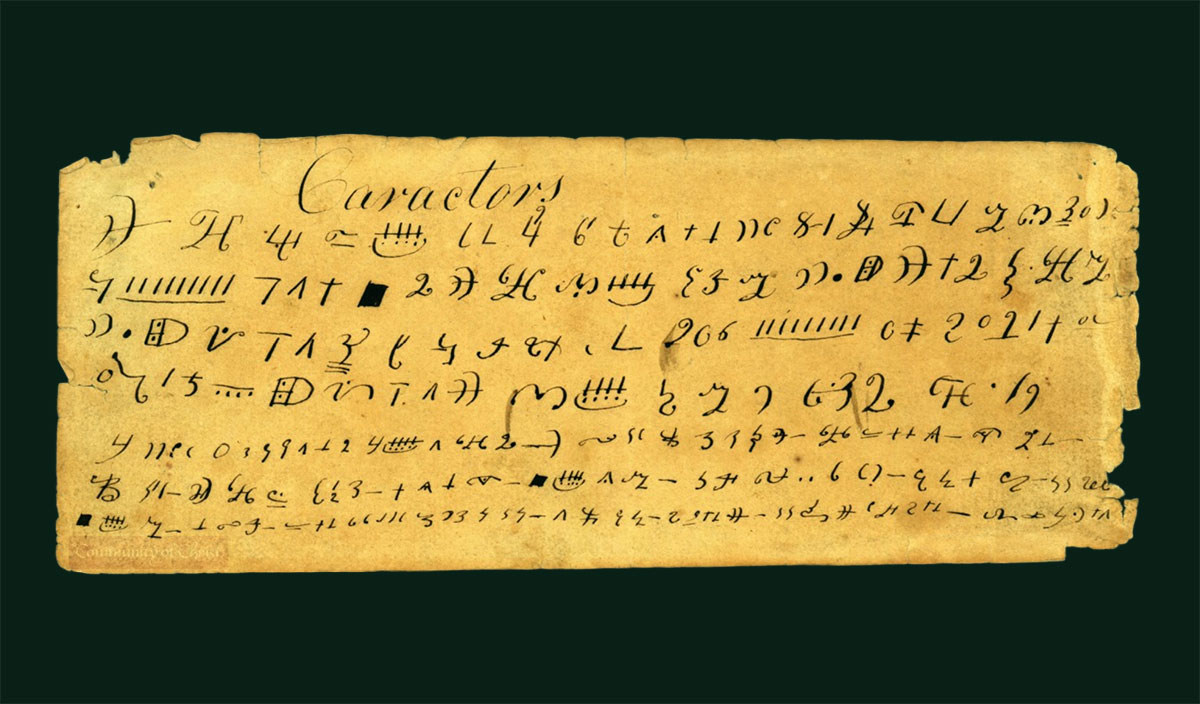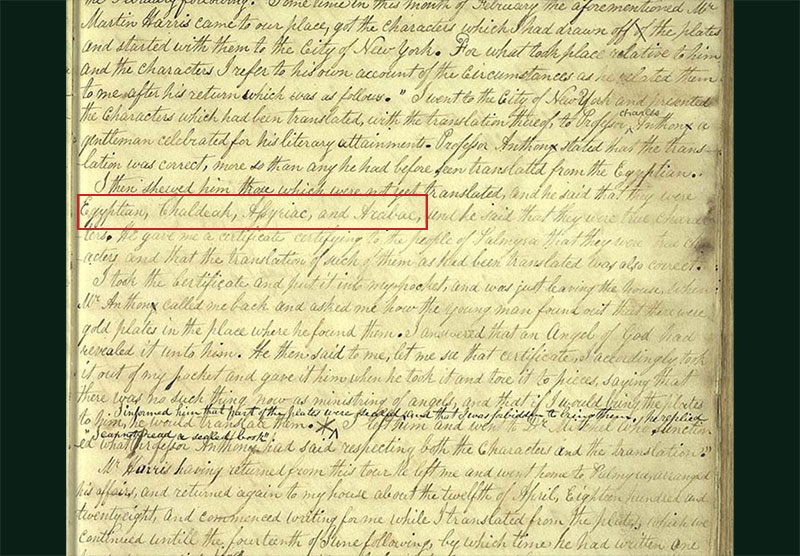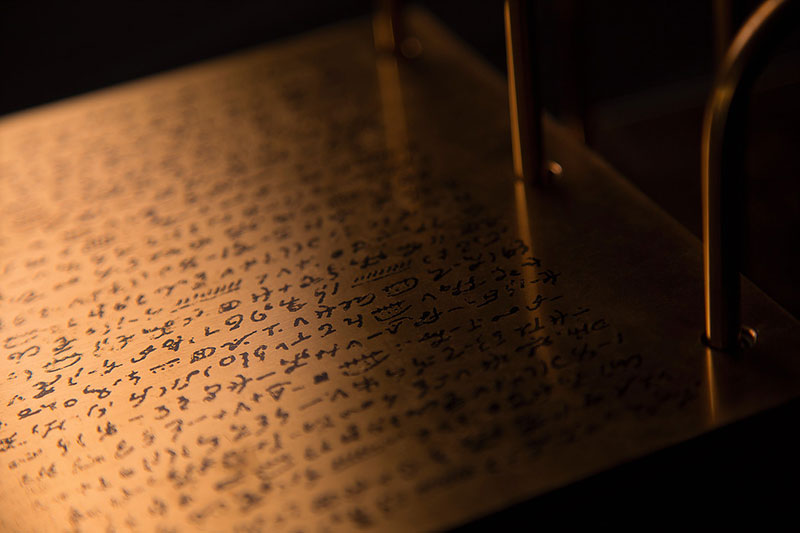
The Know
One of the most important sources related to Martin Harris’s visit and consultation with scholars Samuel Mitchill and Charles Anthon is a small piece of paper known today as the “Caractors” Document (also known as “Anthon Transcript”).1
This document was created most likely sometime between the years 1829–1831 by John Whitmer, who was one of the Eight Witnesses of the Book of Mormon and who was called by revelation to be an early historian and recorder of the Church of Christ (Doctrine and Covenants 47).2 The transcript is filled with characters that are believed to have been taken from the Book of Mormon plates and shown to Mitchill and Anthon by Harris for their examination in the winter of 1828.3
While the document itself is not the original text examined by Mitchill and Anthon, it does appear to be an early copy of the now-lost original prepared by Joseph Smith.4 At some point the document fell into the possession of David Whitmer and has remained in the archives of the Community of Christ (formerly the Reorganized Church of Jesus Christ of Latter Day Saints) in Independence, Missouri.
A description of the characters shown to Mitchill and Anthon by Martin Harris come from several sources (though unfortunately none from Mitchill himself).5 In his 1838 history, Joseph Smith quoted Harris quoting Anthon as determining that the characters were “Egyptian, Chaldaic, Assyriac, and Arabic” (JS–History 1:64).6 In a letter to Eber D. Howe, dated January 15, 1831, W. W. Phelps portrayed Anthon as describing the characters as “ancient shorthand Egyptian.”7

Charles Anthon’s quoted description of the caractors document from the Joseph Smith Papers.
Anthon himself left behind three accounts of his visit with Harris. In the earliest account published in 1834, Anthon described what he saw as “Greek and Hebrew letters, crosses and flourishes, Roman letters inverted or placed sideways . . . arranged in perpendicular columns, and the whole ended in a rude delineation of a circle divided into various compartments, decked with various strange marks, and evidently copied after [a] Mexican Calender.”8
A few years later in 1841 Anthon remembered that “the characters were arranged in columns, like the Chinese mode of writing, and presented the most singular medley that I ever beheld. Greek, Hebrew, and all sorts of letters, more or less distorted, either through unskillfulness, or from actual design, were intermingled with sundry delineations of half moons, stars, and other natural objects, and the whole ended in a rude representation of the Mexican zodiac.”9 A final account left by Anthon in 1844 similarly spoke of the document he was shown “contain[ing] in one or two parallel columns rude imitations of Hebrew and Greek characters together with various delineations of sun, moon, stars, &c.”10
Because “Anthon’s description varies significantly from the surviving fragment of characters,” it is difficult to reconstruct what exactly was represented on the original document prepared by Joseph Smith.11 For example, Anthon spoke of the writing he saw arranged in columns, whereas the “Caractors” document is arranged in rows. Anthon likewise spoke of seeing a “Mexican zodiac” on the text he examined, something absent from the “Caractors” document. Precisely what characters were originally prepared by Joseph and examined by Anthon is therefore not entirely clear.12
Besides the “Caractors” document, “other documents bearing Book of Mormon characters circulated within the early Church as well.”13 This includes copies of characters created and circulated in a Church-affiliated newspaper in New York and by early Latter-day Saint figures such as Oliver Cowdery and Frederick G. Williams.14 However, of “the known extant documents reportedly containing characters from the gold plates, none actually fit the description of the document taken to Anthon,” including the texts prepared by Cowdery and Williams.15 This makes it difficult to know how accurately the characters circulated by these later sources preserved those originally prepared by Joseph Smith.
Scholars have debated whether the characters on the surviving “Caractors” document are authentic. While skeptics of Joseph Smith, beginning with Anthon himself, have largely dismissed the characters as either fabricated or copied from sources available to Joseph, Latter-day Saint scholars have argued for their resemblance to ancient Egyptian scripts, as well as scripts from ancient Mesoamerica.16 A few non-Latter-day Saint Egyptologists have also weighed in, with some having denied any resemblance to ancient Egyptian,17 and others having affirmed such.18 At this point no consensus has been reached as to what script (ancient or modern) the characters of the Anthon transcript closest resemble or should otherwise be compared to.19
This lack of consensus has not stopped some from attempting to translate the Anthon Transcript on their own.20 While attempts to translate the Anthon Transcript may provide interesting perspectives or points to consider, no translation of the text has so far gained widespread acceptance amongst Latter-day Saint scholars or leaders of The Church of Jesus Christ of Latter-day Saints. Any purported translation of the Anthon Transcript should, therefore, be approached very cautiously.21
The Why

Photograph of replica gold plates by Laci Gibbs.
Many questions remain about the Anthon Transcript. Given the contradictory accounts left behind by Charles Anthon and Martin Harris,22 the absence of a translation of the characters which finds broad academic acceptance, and the fact that the documents which survive today are copies (or even copies of copies) of a presumably now-lost original, students of the Book of Mormon and early Latter-day Saint history should be cautious in how they evaluate the surviving evidence.
If modern scholars today are unable to agree with each other over what kind of script the “Caractors” document contains or how to translate the text, as Moroni anticipated would be the case (Mormon 9:32–34), then it seems unlikely that Anthon–––with the limited knowledge of Egyptian available to him in the early nineteenth century–––would have fared much better beyond being able to offer general remarks about the characters (such as their resemblance to other ancient scripts).
This applies even more for Joseph Smith. On his own with what limited education he had, Joseph would have been completely unable to translate the record without divine aid.23 While the Prophet may have initially sought the assistance of scholars in making sense of the characters on the plates, the result of Harris’s meeting with Anthon made it clear that Joseph himself would ultimately have to be responsible for the translation. The circumstances surrounding the creation of the Anthon Transcript therefore offer insight into the process behind the translation of the Book of Mormon.24
When uncertainties such as those surrounding the Anthon Transcript persist, readers can take the opportunity to faithfully apply the counsel given by the Lord in the Doctrine and Covenants to “study [the matter] out in [their] mind” (Doctrine and Covenants 9:8) and to “seek learning, even by study and also by faith” (Doctrine and Covenants 88:118). Future discoveries or more penetrating scholarly analysis of the available evidence might one day solve the mystery of the Anthon Transcript. Until that time, the Book of Mormon itself is available for all to read and gain a testimony of by the power of the Holy Ghost (Moroni 10:4–5).
This KnoWhy was made possible by the generous contribution of the Stephanie Sorensen Charitable Fund.
Further Reading
Michael Hubbard MacKay, “‘Git Them Translated’: Translating the Characters on the Gold Plates,” in Approaching Antiquity: Joseph Smith and the Ancient World, ed. Lincoln H. Blumell, Matthew J. Grey, and Andrew H. Hedges (Salt Lake City and Provo, UT: Deseret Book and Religious Studies Center, Brigham Young University, 2015), 83–116.
Michael Hubbard MacKay, Gerrit J. Dirkmaat, and Robin Scott Jensen, “The ‘Caractors’ Document: New Light on an Early Transcription of the Book of Mormon Characters,” Mormon Historical Studies 14, no. 1 (2013): 131–152.
David E. Sloan, “The Anthon Transcripts and the Translation of the Book of Mormon: Studying It Out in the Mind of Joseph Smith,” Journal of Book of Mormon Studies 5, no. 2 (1996): 57–81.
FARMS Staff, “Martin Harris’s Visit with Charles Anthon: Collected Documents on the Anthon Transcript and ‘Shorthand Egyptian’,” FARMS Preliminary Report (1990).
Stanley B. Kimball, “The Anthon Transcript: People, Primary Sources, and Problems,” BYU Studies 10, no. 3 (1970): 325–352.
- 1. See Michael Hubbard MacKay et al., eds., The Joseph Smith Papers, Documents, Volume 1: July 1828–June 1831 (Salt Lake City, UT: Church Historian’s Press, 2013), 357–361, online at http://www.josephsmithpapers.org/paper-summary/appendix-2-document-1-characters-copied-by-john-whitmer-circa-1829-1831/1; Michael Hubbard MacKay, Gerrit J. Dirkmaat, and Robin Scott Jensen, “The ‘Caractors’ Document: New Light on an Early Transcription of the Book of Mormon Characters,” Mormon Historical Studies 14, no. 1 (2013): 131–52.
- 2. MacKay et al., The Joseph Smith Papers, Documents, Volume 1, 357; “Whitmer, John,” online at www.josephsmithpapers.org.
- 3. See the recent summary of this period in Susan Easton Black and Larry C. Porter, Martin Harris: Uncompromising Witness of the Book of Mormon (Provo, UT: BYU Studies, 2018), 87–101; Book of Mormon Central, “Why Did Martin Harris Consult With Scholars?” KnoWhy 514 (May 7, 2019).
- 4. MacKay et al., The Joseph Smith Papers, Documents, Volume 1, 358–359; MacKay, Dirkmaat, and Jensen, “The ‘Caractors’ Document,” 134–135. In the early 1980s, a forger named Mark Hofmann fabricated what he claimed was the original document prepared by Joseph Smith and shown to Anthon. This forgery should not be confused with the authentic “Caractors” document. See Richard E. Turley, Jr., Victims: The LDS Church and the Mark Hofmann Case (Urbana and Chicago, IL: University of Illinois Press, 1992), 24–39.
- 5. These sources have been collected and discussed in Larry E. Morris, ed., A Documentary History of the Book of Mormon (New York, NY: Oxford University Press, 2019), 224–249.
- 6. See also “History, 1838–1856, volume A-1 [23 December 1805–30 August 1834],” 9, online at http://www.josephsmithpapers.org/paper-summary/history-1838-1856-volume-a-1-23-december-1805-30-august-1834/11.
- 7. William W. Phelps to E. D. Howe, 15 January 1831, in E. D. Howe, Mormonism Unvailed (Painesville, OH: E. D. Howe, 1834), 273; reprinted in Morris, A Documentary History of the Book of Mormon, 240. See further Bruce A. Van Orden, We’ll Sing and We’ll Shout: The Life and Times of W. W. Phelps (Provo and Salt Lake City, UT: Religious Studies Center and Deseret Book, 2018), 33–34.
- 8. Charles Anthon to E. D. Howe, 17 February 1834, in Howe, Mormonism Unvailed, 270–272; reprinted in Morris, A Documentary History of the Book of Mormon, 231.
- 9. Charles Anthon to Thomas Winthrop Coit, 3 April 1841, in Church Record 1 (17 April 1841); reprinted in Morris, A Documentary History of the Book of Mormon, 232.
- 10. Charles Anthon to William E. Vibbert, 12 August 1844, in “A Fact in the Mormon Imposture,” New York Observer 23, no. 69 (May 3, 1845); reprinted in Morris, A Documentary History of the Book of Mormon, 235.
- 11. Dan Vogel, Early Mormon Documents (Salt Lake City, UT: Signature Books, 2002), 4:380n8.
- 12. A preliminary reconstruction can be seen in Stanley B. Kimball, “The Anthon Transcript: People, Primary Sources, and Problems,” BYU Studies 10, no. 3 (1970): 325–352. More recent attempts include Richard E. Bennett, “Martin Harris’s 1828 Visit to Luther Bradish, Charles Anthon, and Samuel Mitchill,” in The Coming Forth of the Book of Mormon: A Marvelous Work and a Wonder, ed. Dennis L. Largey et al. (Salt Lake City and Provo, UT: Deseret Book and Religious Studies Center, Brigham Young University, 2015), 103–115; Michael Hubbard MacKay, “‘Git Them Translated’: Translating the Characters on the Gold Plates,” in Approaching Antiquity: Joseph Smith and the Ancient World, ed. Lincoln H. Blumell, Matthew J. Grey, and Andrew H. Hedges (Salt Lake City and Provo, UT: Deseret Book and Religious Studies Center, Brigham Young University, 2015), 83–116.
- 13. MacKay, Dirkmaat, and Jensen, “The ‘Caractors’ Document,” 136.
- 14. MacKay, Dirkmaat, and Jensen, “The ‘Caractors’ Document,” 134–138; MacKay et al., The Joseph Smith Papers, Documents, Volume 1, 361–367. The individual texts can be viewed online at Appendix 2, Document 2a. Characters Copied by Oliver Cowdery, circa 1835–1836, Appendix 2, Document 2b. Writings and Characters Copied by Frederick G. Williams, circa Early to Mid-1830s, and Appendix 2, Document 3. Stick of Joseph, 1844, all online at www.josephsmithpapers.org.
- 15. MacKay, Dirkmaat, and Jensen, “The ‘Caractors’ Document,” 136–137.
- 16. See Ariel L. Crowley, “The Anthon Transcript,” Improvement Era (January 1942): 15, 58–60; (February 1942): 76–80, 124–125; (March 1942): 149–151, 182–183; (September 1944): 542–543, 576–583; About the Book of Mormon (Idaho City, ID: Deseret News Press, 1961), 12–55; Carl H. Jones, “The ‘Anthon Transcript’ and Two Mesoamerican Cylinder Seals,” Newsletter and Proceedings of the Society for Early Historical Archaeology 122 (September 1970): 1–8; FARMS Staff, “Martin Harris’s Visit with Charles Anthon: Collected Documents on the Anthon Transcript and ‘Shorthand Egyptian’,” FARMS Preliminary Report (1990); John L. Sorenson, Mormon’s Codex: An Ancient American Book (Salt Lake City and Provo, UT: Deseret Book and Neal A. Maxwell Institute for Religious Scholarship, 2013), 699–702.
- 17. Alan H. Gardiner to Paul M. Hanson, 8 June 1956, and John A. Wilson to Paul M. Hanson, 7 June 1956, published in Paul M. Hanson, “The Transcript from the Plates of the Book of Mormon,” Saints Herald 103 (12 November 1956): 1098.
- 18. William C. Hayes to Paul M. Hanson, 8 June 1956, published in Hanson, “The Transcript from the Plates of the Book of Mormon,” 1098 (cf. Stanley B. Kimball to John W. Welch, 1 November 1994); Richard Parker to Marvin W. Cowan, 22 March 1966; Richard Bushman to Marvin S. Hill, 30 March 1985, cited in FARMS Staff, “Martin Harris’s Visit with Charles Anthon,” 7n27.
- 19. Latter-day Saint Egyptologist John Gee summarized the difficulty of simply comparing the Anthon Transcript with known ancient scripts when he wrote that “the Anthon transcript does not look like hieratic or Mayan but we would not expect it to. Some of the individual signs could make sense as Roman period demotic, but there is no reason to expect the script of the Nephites to develop the same way as Egyptian demotic across the ocean.” John Gee, “The Hagiography of Doubting Thomas,” FARMS Review of Books 10, no. 2 (1998): 172.
- 20. See for instance Stan and Polly Johnson, Translating the Anthon Transcript (Parowan, Utah: Ivory Books, 1999); Jerry D. Grover, Jr., Translation of the “Caractors” Document (n.p.: 2015).
- 21. “A major obstacle faces those attempting a translation of the Anthon transcript —the corpus is not large enough to render decipherment feasible. The same, of course, is true of the writing on the Phaistos disk and the examples of the Isthmian or Mixtec scripts. There is still some debate about whether scholars have cracked some of the scripts that have a slightly larger corpus, like Linear A and Harrapan. Scripts that actually have been solved —such as hieroglyphic Hittite, Maya, cuneiform, Egyptian hieroglyphs, hieratic, demotic, and Ugaritic —all have immense bodies of texts. I cannot recall a single example of someone being able to decipher an unknown language written in an undeciphered script that was attested in only a single, small, monolingual document.” John Gee, “Some Notes on the Anthon Transcript,” FARMS Review of Books 12, no. 1 (2000): 8.
- 22. See the analysis in Richard L. Bushman, Joseph Smith and the Beginnings of Mormonism (Urbana and Chicago, IL: University of Illinois Press, 1984), 86–89.
- 23. See Book of Mormon Central, “Why Did the Book of Mormon Come Forth as a Miracle?” KnoWhy 273 (February 10, 2017).
- 24. David E. Sloan, “The Anthon Transcripts and the Translation of the Book of Mormon: Studying It Out in the Mind of Joseph Smith,” Journal of Book of Mormon Studies 5, no. 2 (1996): 57–81.
Continue reading at the original source →



